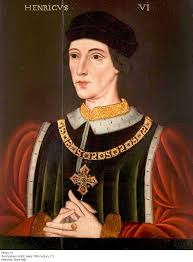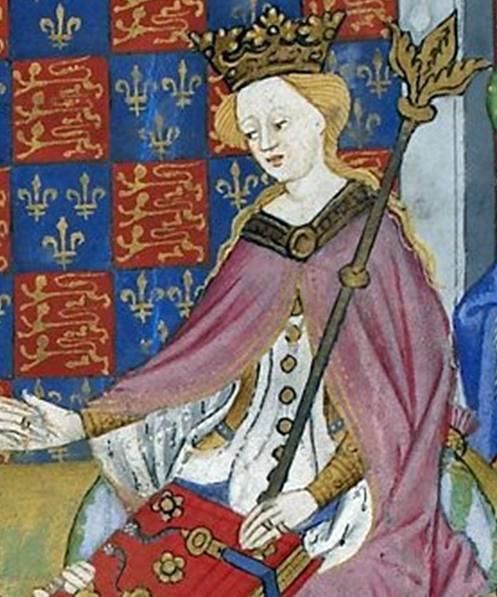http://thekingsandqueens.wordpress.com/2014/03/
Henry VI, (6th December 1471 – 21st May 1471) was king of England from 1422 to 1461 and again from 1470 and 1471. He also held a disputed claim of the kingship of France between 1422 and 1453. Reports describe him as very pious and peaceful man, who was not suited to the bloodshed of the dynastic wars that blighted his reign, such as the War of the Roses. Bouts of insanity led to his wife Margaret of Anjou taking control of his kingdom. His weakening position led to his own downfall and the collapse of the House of Lancaster and the rise of the House of York, eventually the conflict between the two would become known as the War of the Roses.
Henry was the only child of Henry V and was born on 6th December 1421 at Windsor Castle. He succeeded the throne of England after his father’s death on 31st August 1422 at just the age of nine months old. He was the youngest person ever to succeed the English throne. Two months later and still not one year old Henry also became titular King of France on the death of his grandfather Charles VI in accordance with the Treaty of Troyes. His mother, Catherine of Valois (Charles daughter) was twenty years old herself this point and viewed with considerable suspicion by English nobles preventing her from playing a full roll in her son’s upbringing.
On 28th September 1423 the nobles all swore loyalty to Henry VI and a parliament was summoned in the Kings name as a regency council to govern until the King should come of age. One of Henry V’s surviving brothers; John, Duke of Bedford was appointed senior regent of the realm and was in charge of the ongoing war in France. During Bedford’s absence Henry V’s other surviving brother Humphrey, Duke of Gloucester was appointed Protector and Defender of the Realm. His duties were limited to keeping the peace and summoning parliament. Henry V’s half uncle; Henry Beaufort, Bishop of Winchester was an important member of the council. After the Duke of Bedford’s death in 1435, the Duke of Gloucester claimed the regency for himself but was contested by other members of the council.
Henry’s half brothers Edmund and Jasper, through his mother and her new husband Owen Tudor were both given earldoms. Edmund was the father of Henry Tudor who would become Henry VII, King of England. From 1428 Henry’s tutor was Richard de Beauchamp, Earl of Warwick.
In reaction to Charles VII Valois’ coronation as King of France in Reims Cathedral on 17th July 1429, Henry was soon crowned King of England at Westminster Abbey on 6th November 1429. He was then crowned King of France at Notre Dame de Paris on 16th December 1431. It was not though until 13th November 1437, just before his sixteenth birthday that he gained some form of independent authority. His want to gain some form of authority was clear to see when the place named of signing writs was changed from Westminster (where the council sat) to Cirencester (where the king was) in 1434. Henry then gained full royal powers when he came of age.
Henry was declared of age in 1437 which was the same year that his mother died. Henry took the reins of government gaining full control, although this shy and pious boy averse to deceit and bloodshed soon allowed the court to be dominated by a few noble favourites who clashed on the matter of the French war. After the death of Henry V, England lost momentum in the Hundred Year War. Military victories by Joan of Arc helped the Valois family gain ground. The young King favoured peace which was preached to him by Cardinal Beaufort and William de la Pole, Earl of Suffolk. On the other side Humphrey, Duke of Gloucester and Richard, Duke of York preferred a continuation of the war.
Cardinal Beaufort and the Earl of Suffolk persuaded the King that the best way to pursue peace with France was through a marriage to Margaret of Anjou. Margaret, a niece to King Charles VII of France was apparently very beautiful and Henry agreed straight away. Suffolk was sent to negotiate with Charles. Charles agreed to the marriage as long he did not have to provide the customary dowry and instead receive the lands of Maine and Anjou from the English. These conditions were agreed in the Treaty of Tours, but the cession of Maine and Anjou was kept secret from the Parliament in London as it was believed that it would be hugely unpopular with the English populace.
The marriage took place at Tichfield Abbey on 23rd Aril 1445, one month after Margaret’s fifteenth birthday. Henry wavered the agreement to give up Maine and Anjou to Charles after he realised just how unpopular this would have been. Margaret was determined to make him to see it through and after the deal became public knowledge in 1446, public anger was angered at the Earl of Suffolk, with Margaret and Henry determined to protect him.
One thing is certain within Henry’s early life and with his gain of full royal powers. He was easily led and influenced by others. Shy, pious a peaceful man never having the full set of skills for rule. Maybe his weakness led to the War of the Roses and the power struggle that was going on between his most trusted and powerful advisors. It was clear to see the stage was set by this point and that the audience was about to sit down for a feud that would cause so much bloodshed across England.


No comments:
Post a Comment